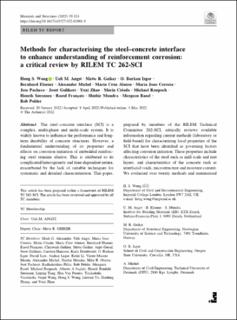Methods for characterising the steel–concrete interface to enhance understanding of reinforcement corrosion: a critical review by RILEM TC 262-SCI
| dc.contributor.author | Wong, Hong | |
| dc.contributor.author | Angst, Ueli M | |
| dc.contributor.author | Geiker, Mette Rica | |
| dc.contributor.author | Isgor, Burkan | |
| dc.contributor.author | Elsener, Bernhard | |
| dc.contributor.author | Michel, Alexander | |
| dc.contributor.author | Alonso, Maria Cruz | |
| dc.contributor.author | Correia, Maria Joao | |
| dc.contributor.author | Pacheco, Jose | |
| dc.contributor.author | Zhao, Yuxi | |
| dc.contributor.author | Criado, Maria | |
| dc.contributor.author | Raupach, Michael | |
| dc.contributor.author | Sørensen, Henrik | |
| dc.contributor.author | Francois, Raoul | |
| dc.contributor.author | Mundra, Shishir | |
| dc.contributor.author | Rasol, Mezgeen | |
| dc.contributor.author | Polder, Rob | |
| dc.date.accessioned | 2022-11-28T07:27:41Z | |
| dc.date.available | 2022-11-28T07:27:41Z | |
| dc.date.created | 2022-05-05T10:39:08Z | |
| dc.date.issued | 2022 | |
| dc.identifier.issn | 1359-5997 | |
| dc.identifier.uri | https://hdl.handle.net/11250/3034326 | |
| dc.description.abstract | The steel–concrete interface (SCI) is a complex, multi-phase and multi-scale system. It is widely known to influence the performance and long-term durability of concrete structures. However, a fundamental understanding of its properties and effects on corrosion initiation of embedded reinforcing steel remains elusive. This is attributed to its complicated heterogeneity and time-dependent nature, exacerbated by the lack of suitable techniques for systematic and detailed characterisation. This paper, prepared by members of the RILEM Technical Committee 262-SCI, critically reviews available information regarding current methods (laboratory or field-based) for characterising local properties of the SCI that have been identified as governing factors affecting corrosion initiation. These properties include characteristics of the steel such as mill scale and rust layers, and characteristics of the concrete such as interfacial voids, microstructure and moisture content. We evaluated over twenty methods and summarised their advantages, applications and limitations. The findings show a severe lack of well established, non-destructive techniques that are suitable for direct monitoring of the SCI at a representative scale with sufficiently high resolution (spatial, temporal), particularly for moisture related aspects. Several promising novel techniques with significant potential for further development and application were identified and discussed. Finally, we provide several recommendations for future research needs that are required to advance this critically important topic. | |
| dc.language.iso | eng | en_US |
| dc.publisher | Springer | en_US |
| dc.rights | Navngivelse 4.0 Internasjonal | * |
| dc.rights.uri | http://creativecommons.org/licenses/by/4.0/deed.no | * |
| dc.title | Methods for characterising the steel–concrete interface to enhance understanding of reinforcement corrosion: a critical review by RILEM TC 262-SCI | en_US |
| dc.title.alternative | Methods for characterising the steel–concrete interface to enhance understanding of reinforcement corrosion: a critical review by RILEM TC 262-SCI | en_US |
| dc.type | Journal article | en_US |
| dc.type | Peer reviewed | en_US |
| dc.description.version | publishedVersion | en_US |
| dc.source.volume | 55 | en_US |
| dc.source.journal | Materials and Structures | en_US |
| dc.identifier.doi | 10.1617/s11527-022-01961-5 | |
| dc.identifier.cristin | 2021680 | |
| cristin.ispublished | true | |
| cristin.fulltext | preprint | |
| cristin.qualitycode | 1 |

